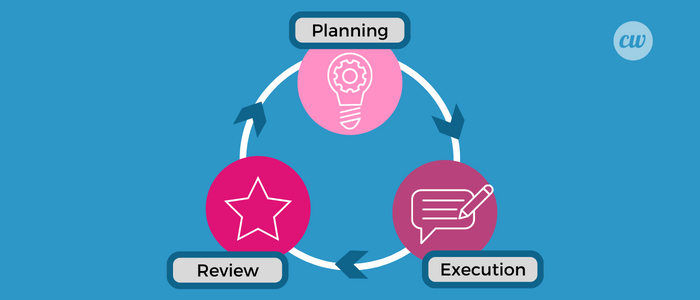
How to Create a Successful Content Partnership Strategy
The best content marketing strategies rely on the consistent creation and publication of high-quality content. As your business grows and you introduce new products or go after new markets, it can be difficult to scale your content operations with just your in-house team.
That may be why, according to the Content Marketing Institute’s 2021 Benchmark Report, content creation is the number one most outsourced content marketing activity for B2B organizations.

The same report lists finding a partner with topic expertise (69%), budgeting (51%), and finding partners who understand your audience (43%) as the top three challenges of outsourcing your content creation.
So, how do you outsource high-quality content without spending your entire marketing budget?
The key lies in creating a clear and effective content partnership strategy. Keep reading to discover the benefits of a productive content marketing partnership and the steps you can take to set yourself up for success.
Here’s what you’ll learn:
Benefits of Good Content Partnerships
Stages of the Content Creation Workflow
7 Tips for a Successful Content Partnership Strategy
Final Thoughts: How to Create a Successful Content Partnership Strategy
Benefits of Good Content Partnerships
Scaling content marketing operations through outsourcing requires the cultivation of good relationships with content partners, rather than treating content creation as a one-off transaction.
When your content partners get to know your needs, they’re better equipped to provide you with high-quality assets that resonate with your audience and drive results.
As your relationship grows, you‘ll spend less time and money on editing and revisions, allowing your team to focus on strategy and distribution.
Building a relationship with your content partners transforms them into an asset for your team. Working with agencies gives you access to diverse perspectives, types of expertise, and content creation tools.
Ultimately, a good content partnership means your expanding your in-house team with an account or project manager who understands your brand, goals, and audience and can act as a strategic partner to support your long-term growth.
Stages of the Content Creation Workflow
Before we look at the top tips to creating a successful content partnership, let’s go over the three primary stages in the content creation workflow: planning, execution, and review.

Planning
During the planning stage, you meet with your content creation partner to align on a project’s goals, define deliverables, and set a timeline.
This stage can look different depending on how you want to work. For example, you may choose to come prepared with a project brief and list of deliverables and use this time to explain your needs and answer questions.
Alternatively, you can have a more collaborative relationship with your partner where both parties brainstorm content strategies and pitch topics.
How to make the planning stage successful: Come prepared with preliminary information about your content goals and audience, or even share it with your partner before meetings to have a well-informed discussion.
Execution
Throughout the execution stage, your content partner takes the information from planning and creates the deliverable. Early in your relationship, there might be more back and forth communication with your partner as they’re getting to know your brand style, audience, and content standards.
How to make the execution stage successful: Provide clear project briefs and guidelines that help your outsourcing partner understand your expectations and make yourself available to answer questions.
Review
In the reviewing stage, your content partner presents you with a first draft of the deliverable. Here, you have the chance to provide feedback and request revisions. You can also help clarify your brand’s voice and offer tips and examples of how to capture it better.
How to make the review stage successful: Explain the reasoning behind all feedback and give specific actionable revision requests. Positive notes show what works for you, and constructive criticism identifies opportunities for improvement.
7 Tips for a Successful Content Partnership Strategy
The Global Survey on Freelancing Report found that 69% of freelancers feel they are treated fairly and with respect by clients and less than half of respondents say their clients know how to work effectively with freelancers. It is vital to the partnership that you collaborate respectfully and productively with your content provider in order to produce high-quality work with the long term.
Here are 7 actionable steps you can take to improve your work with freelancers and build a strong content partnership.
1. Align Internal Stakeholders
Before meeting with your content partner, budget time to figure out who needs to be involved. You may have several internal stakeholders on your content creation team, such as marketing managers, product experts, editors, account managers, and sales representatives.
After assembling the team, specify who’s responsible for signing off on aspects of the project such as pricing, topics, revisions, and changes to the partnership agreement. At this stage, it’s also essential that your internal team understands and agrees on content goals and KPIs for measuring success.
And finally, designate a point of contact for your content partner. This person can help direct questions and discussions to the right person on your team.
Your content partner will appreciate knowing who to contact in case they have questions, and your team will have someone assigned to streamline communications.
2. Provide a Comprehensive Style Guide
Content creators and agencies work for several clients at once, and each has its own style preferences. Providing a thorough style guide for your brand helps content partners create a first draft that’s consistent with your existing content.
In particular, your style guide should include:
- A definition of your target audience(s)
- Grammar and formatting rules
- SEO best practices to follow
- Description of voice, tone, and style
- Guidelines for media, research, and sourcing
You should also link to relevant content you’ve already created, like white papers, case studies, and product/solution resource decks. That helps them get a feel for your brand’s voice so you can spend less time revising style and tone.
If you don’t have a style guide for content creators, you can work with your content partner to create one.
3. Create Thorough Content Briefs

Some marketing teams might wonder why they need to provide a content brief if they’re hiring a writer. When you hire external content creators, you have to remember they don’t have your institutional knowledge or your department’s goals top of mind, especially at the beginning of the relationship.
They’re not in the office absorbing conversations occurring on a daily basis, so providing as much content and details upfront is best. The more expectations you can define about the deliverable, the less time you’ll spend on revisions.
Try to avoid jargon or abbreviations that someone outside of your company won’t know, and give your content partner a list of competitors you don’t want them to link to or mention.
Ultimately, a good content brief provides a clear picture of what the final deliverable should look like by including information such as word count and aspirational samples.
4. Communicate Your Process
Effective communication is critical to outsourcing success. Your content partner should understand what to expect in your process.
Share relevant content calendars, outlines, upcoming campaigns, etc. and explain how your team works internally. Your content partner should have a full understanding of your needs and expectations, which will inform how you collaborate.
If your content partner offers project management software, use it as your primary collaboration tool so both parties can track progress and access information in one place.
5. Budget Time for Reviews
After receiving the first draft of a deliverable from your partner, it’s time to review and provide constructive feedback. Don’t forget to plan time for the reviewing stage with consideration of your deadline/publishing date, and give the writer enough time to revise.

Be sure to provide context for criticism, especially at the beginning of the relationship.
Specifically, explain why something doesn’t work or what alternatives you prefer. Without context, it’s difficult for your content partner to know how to tailor content for your brand.
Here’s an example:
- Revision request without context: “This sentence is confusing.”
- Revision request with context: “Our audience doesn’t know this term. Can you provide an example that explains it?”
Giving your writer well-thought-out feedback on a piece helps them understand your preferences and content standards. In that respect, it’s also important to highlight what you liked (and why) so they know what to continue doing and build upon ideas that work for your brand.
Your content partner will become more familiar with your preferences through the review process, making each new piece more aligned with your expectations as the relationship grows.
6. Share Performance Metrics
Remember, you’ll have much more success if you think of outsourcing as creating a strategic partnership. Sharing performance metrics with content partners gives them a better understanding of what resonates with your audience and drives the best results for your KPIs.
Tell them if their work receives positive feedback from your customer base or exceeds KPI goals. If a piece of content doesn’t live up to expectations, let them know and invite them to help you problem-solve for future assignments and topics.
7. Set Yourself up for Scale
According to the Semrush State of Content Ops & Outsourcing report, scaling content production is the top reason marketing teams hire outside writers. When you outsource, the key to scaling lies in building a long-term relationship with your content marketing partners.
To do this, you want your content partner to see you as a valuable client, which means you’ve got to be good for their business too.
You can do that by committing to a regular publishing cadence (which gives them consistent work) and taking advantage of other service offerings like monthly topic pitching sessions, editorial calls, and SEO keyword research. That creates a deeper relationship and encourages both parties to be more invested and involved in your content marketing strategies.
As your relationship grows, you’ll both begin to see it as a strategic partnership instead of a strictly transactional interaction.
Final Thoughts: How to Create a Successful Content Partnership Strategy
Bringing on an outside content partner is an excellent way to scale your content marketing efforts and leverage new expertise and perspectives. But outsourcing content creation doesn’t mean you get to outsource all responsibility.
The quality of your final deliverables depends on the work you put in and the type of partnership you build. By investing time and effort up front, you’re building the foundation to create a content marketing program that’s successful, reliable, and agile in the long run.
Maddy Osman creates engaging content with SEO best practices for marketing thought leaders and agencies that have their hands full with clients and projects.




